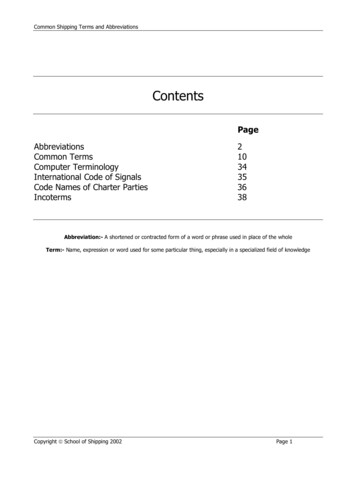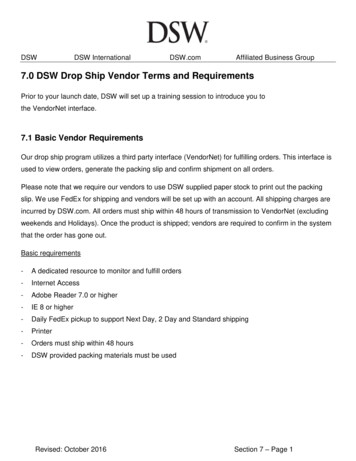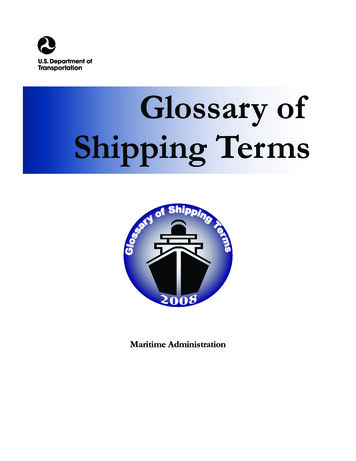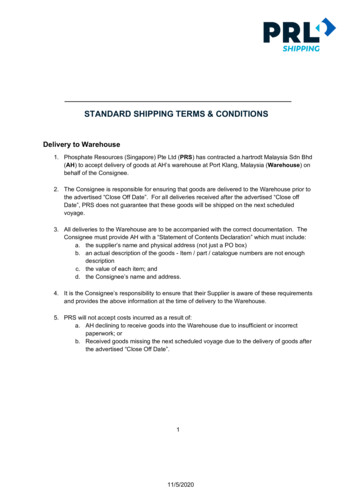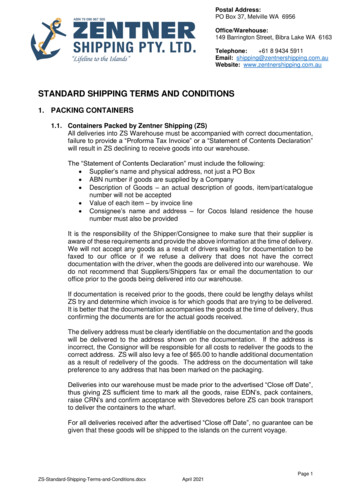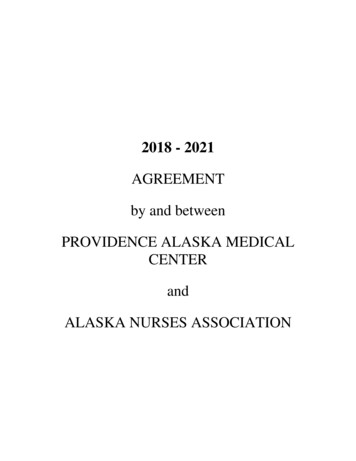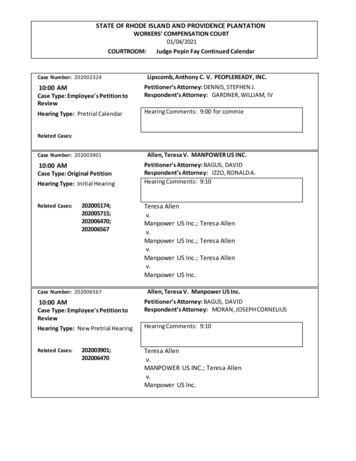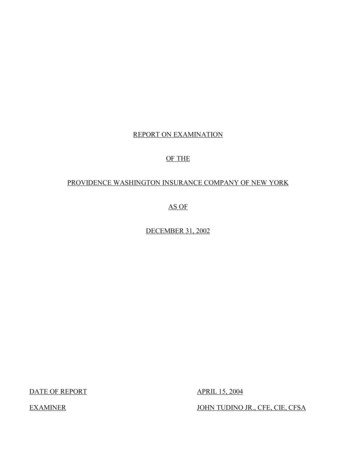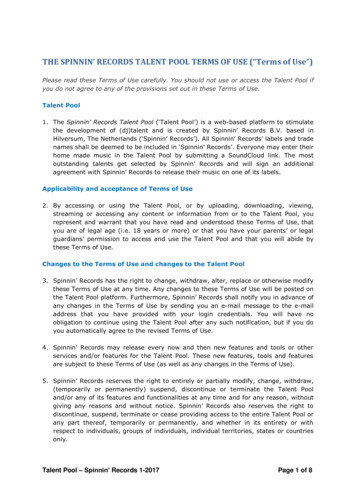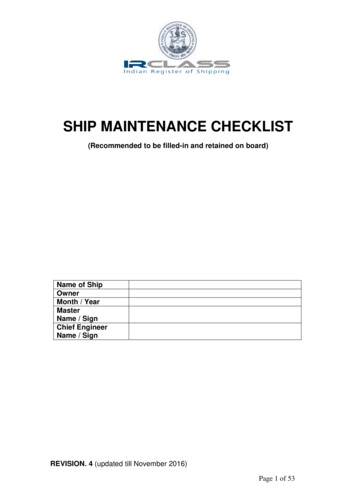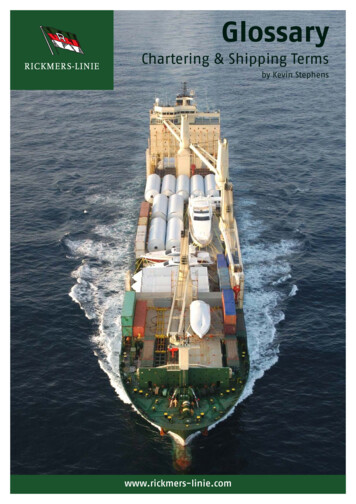
Transcription
GlossaryChartering & Shipping Termsby Kevin Stephenswww.rickmers-linie.com
We thank Kevin Stephens from Project Professionals Group (PPG) for his permission to publish hisChartering and Shipping Terms on our website.Rickmers-LinieHamburgChartering & Shipping Terms by Kevin Stephens & Project Professionals Group.Edition for Rickmers-Linie Website dated August 2007Please seek permission from the Author, Kevin Stephens, before republishing these Chartering and GeneralShipping Terms & Conditions.If you wish to get in touch with Mr. Stephens send a mail to: kevinstephens@wwproject.netThese Terms & Definitions are for general explanations only and not legally binding. A term or definitionmentioned herein does not neccessarily reflect the meaning or interpretation applicable to a specific businessconcluded with Rickmers-Linie. We therefore recommend to check the correct meaning of a term in ourquotations and/or bookings with your local Rickmers office.
Terms & DefinitionsDetailed below in this document is our non-exhaustive list of frequently used chartering and general shippingabbreviations and their definitions that you may come across from time to time.FIOS (FREE IN, OUT, STOWED):It is most important to remember that the “Free” reference is viewed from the Ship Owners point of view - not the Shipper’s.Some Shippers get caught out when they read the word “Free” as they incorrectly believe that it refers to them.Freight rates quoted on a FIOS basis specifically exclude all aspects relating to cargo handling operations. The ship is onlyresponsible for expenses arising as a result of the ship calling into the port,i.e. tugs, pilots and light dues etc. Another very important consideration when booking cargo on FIOS terms is that the shipdoes not bear any responsibility for the speed of loading or discharging.Usually the rate agreed includes a fixed “free” period of time for loading/discharging operations, after which time a dailydemurrage is incurred. Obviously this is of paramount importance where port congestion or stevedoring performance isuncertain. There are many overseas ports which fall into this category and particularly where vessel demurrage rates canvary significantly, depending on the size and type of ship nominated to undertake the particular project.LINER TERMS - GENERAL STATEMENT:Liner Terms is a very ambiguous statement and can be interpreted in a variety of ways in different ports of the worldand by different Ship Owners/Agents. Personally we would prefer to clearly define the extent of responsibility when quotingon this basis.LINER TERMS HOOK / HOOK:Given that this is a notional point in chartering terms, this is best described as the Shipper/Receiver arranging fordelivery/receival of cargo to/from directly under ships hook and the ship paying for the labour to stow the cargo in thevessels cargo holds, as well as on-board lashing & securing and provision of dunnage materials, and to dischargeagain over the ship’s side. Shore based stevedoring aspects remain the responsibility of the shipper/receiver, however,there are some Owners that may incorporate these costs into their LTHH rate. Once again, ask Owners to clearly definethis aspect.Wharfage charges/dues/taxes can be a contentious issue but are usually considered to be for the Shippers/Receiversaccount and there may also be many other statutory levies on cargo or freight that may apply. Many Shippers/Receiversare unaware of these additional costs and do not include them into their costing and consequently may be left withan unexpected considerable expense at the completion of a project.FULL LINER TERMS:This is somewhat a vaguer term given different port practices. However, it generally implies that the freight amountprovided includes both shore based and on-board stevedoring, lashing/unlashing, dunnage materials, securing/unsecuringand all costs of presenting to/receiving the cargo from the ship’s side; with the shippers/receivers just bearing the cost ofdischarging from/reloading to the transport, along with the usual port charges/levies/taxes etc. Frequently the terms arevaried at different ends of the voyage i.e. FILO (Free In/Liner Out), LIFO (Liner In Free Out) or FIFO (Free In/Free Out) etc. To beabsolutely sure of all liabilities, it is always advisable to request that terms clearly and concisely indicate what is/isn’tincluded in your particular contract - in layman’s terms.I hope you will find this information both helpful and informative. If you require clarification on any aspect, or have anyfurther questions, please don’t hesitate to contact us at any time.
Terms & DefinitionsABBREVIATIONMEANINGAAAlways AfloatAAAAAlways Accessible Always AfloatAAOSAAlways Afloat or Safe Aground. Condition for a vessel whilst in portAARAAmsterdam-Antwerp-Rotterdam AreaABAFTToward the rear (stern) of the ship. Behind.ABOARDOn or within the shipAABOVE DECKOn the deck (not over it – see ALOFT)ABSORPTIONAcceptance by the carrier of a portion of a joint rate or charge which is lessthan the amount which it would receive for the service in the absence ofsuch joint rate or charge.ABTAboutACCEPTANCE OF GOODSThe process of receiving a consignment from a consignor, usually againstthe issue of a receipt. As from this moment and on this place the carrier’sresponsibility for the consignment begins.ACKNOWLEDGEMENT OF RECEIPTA notification relating to the receipt of e.g. goods, messages and documents.Active Inventory covers raw material, work in progress, finished products thatwill be used or sold within a given period without extra cost or loss. This termdoes not cover the so-called reserve inventory.ACTUAL DEMANDCustomers’ orders and often also the allocation of items, ingredients and/orraw materials to production or distribution.ACTUAL VOYAGE NUMBERA code for identification purposes of the voyage and vessel which actuallytransports the container/cargo.ADCOMAddress CommissionADDED VALUEThe value attributed to products, and services as the result of a particularprocess (e.g. production process, storage, transport).ADDENDUMAdditional chartering terms at the end of a charter party.ADVANCE ARRANGEMENTAn agreement between the shipper and the carrier, concerning contactsbetween those parties prior to tendering the consignment.ADVANCED AMOUNTCash or cash equivalents expressed in a monetary amount given to a driverto cover expenses during a trip.ADVANCED CHARGEA charge paid by a carrier to an agent or to another carrier, which thedelivering carrier then collects from the consignee. Such charges are usuallyfor agents’ forwarding fees and incidental expenses paid out of pocket foraccount of the shipment by an agent or other carrier (aircargo).ADVANCED INTERLINEAn interline carrier that picks up cargo from the shipper and deliversit to another carrier for shipment to the consignee.ADVICE NOTEA written piece of information e.g. about the status of the goods.AFSPSArrival First Sea Pilot Station (Norway)AFFREIGHTMENTThe hiring of a ship in whole or part.AFTAt or towards the stern or rear of a ship.AGENCY FEEFee payable by a shipowner or ship operator to a port agent. by Kevin Stephens. Do not republish these these Chartering and General Shipping Terms & Conditions without permission from the author.2
Terms & DefinitionsAABBREVIATIONMEANINGAGENTSIntelligent software that can be used in an exchange or auction to monitorprices and conditions on behalf of buyer and supplier and in some cases toautomatically execute trades.AGGREGATE INVENTORYThe inventory for any group of items or products, involving multiple stockkeeping units. Synonym: Aggregate Stock.AGROUNDTouching or fast to the bottom.AGWAll Going WellAHLAustralian Hold LaddersAIDS TO NAVIGATIONArtificial objects to supplement natural landmarks indicating safe and unsafewaters.AIMSee Automatic Identification Manufacturers.ALLOCATIONThe process of assigning activities, costs or facilities e.g. space to a certainorganizational units.ALLOTMENTA share of the capacity of a means of transport assigned to a certain party,e.g. a carrier or an agent, for the purpose of the booking of cargo for aspecific voyage.ALOFTAbove the deck of the shipAMIDSHIPSIn or toward the centre of the shipANCHORAGEA place suitable for anchorage in relation to the wind, seas and bottom.ANTHAMAntwerp-Hamburg RangeAPPARELA vessel’s outfit, such as rigging, anchor and life boats. The term used indistribution/transport of clothing for a single piece of clothing, a garment.APPLICABLE SERVICE PROVIDERAn online outsourcer or hosting service for applications, letting Net marketmakers rent instead of buying applications and services such as auctions,exchanges and catalog aggregation. Many application vendors are moving to ahosting model, but ASPs are often application-agnostic, plugging a feature ofone application into a marketplace when appropriate and using anotherfeature from another vendor elsewhere.APPROVED CONTINUOUSEXAMINATION PROGRAM (ACEP)An agreement between the owners of the equipment and the responsiblegovernmental body to allow continuous examination of the equipment (e.g.containers).APRONSee PlatformAPRYCLEEA network of national information centres of information technologies.APSArrival Pilot StationARAGAmsterdam-Rotterdam--Antwerp-Gent RangeAREA OF REPAIRGeographical area where a container is under repair.ARBITRATIONMethod of settling disputes which is usually binding on parties. A clauseusually in a charter party.AREA CODEA code for the area where a container is situated.AREA OFF HIRE LEASEGeographical area where a leased container becomes off hire.AREA OFF HIRE SUB-LEASEGeographical area where a subleased container becomes off hire.AREA ON HIRE LEASEGeographical area where a leased container becomes on hire.AREA ON HIRE SUB-LEASEGeographical area where a subleased container becomes on hire. by Kevin Stephens. Do not republish these these Chartering and General Shipping Terms & Conditions without permission from the author.3
Terms & DefinitionsABBREVIATIONMEANINGARRIVAL NOTICEA notice sent by a carrier to a nominated notify party advising of thearrival of a certain shipment.ARTICLES DANGEREUX DE ROUTE(ADR)An European agreement concerning the international carriageof dangerous goods by road.A/SAlongsideASBAAmerican Shipbrokers AssociationASPWAny Safe Port in the WorldASSEMBLYThe stage of production in which components are put together intoan end product appropriate to the process concernedA-BASSIGNMENTThe transfer of certain rights from one party to anotherASTERNIn the back of the ship, opposite of aheadATDNSHINCAny Time Day/Night Sundays and Holidays IncludedATHWARTSHIPSAt right angles to the centreline of the shipATUTCActual Times Used to CountAUCTIONSLet multiple buyers bid competitively for products from individual suppliers.Suitable for hard-to-move goods such as used capital equipment (forklifts)and surplus or excess inventory. Prices only move up, but buyers can buybelow list prices while sellers sell for more than a liquidator pays. Auctionsare becoming a feature of many Net markets, but some use auctions astheir primary market mechanism. Examples: AdAuction, TradeOut.com (usedequipment).AUDITA methodical examination and review of a situation or condition (as withina business enterprise) concluding with a detailed report of findings.AUTHENTICATIONProof by means of a signature or otherwise that a certain document orcertain data is of undisputed origin and genuine.AUTHORISATIONThe commission to a certain person or body to act on behalf of anotherperson or body. The person or body can be authorized e.g. to issue Billsof Lading or to collect freight.AUTO CONTAINERContainer equipped for the transportation of vehicles.AUTOMATIC IDENTIFICATIONA means of identifying an item e.g. a product, parcel or transport unit bya machine (device) entering the data automatically into a computer. Themost widely used technology at present is bar code; others include radiofrequency, magnetic stripes and optical character recognitionAUTOMATIC IDENTIFICATIONMANUFACTURERS (AIM)International organization of companies and/or associations involved orinterested in automatic identification.AVERAGEIn marine insurance: A loss or damage to or in respect of goods orequipment. The numerical result obtained by dividing the sum of two ormore quantities by the number of quantities.AVERAGE ADJUSTERSIn general average affairs average adjusters are entrusted with the taskof apportioning the loss and expenditure over the parties interested in themaritime venture and to determine which expenses are to be regarded asaverage or general average.BACKBONEA central high speed network that connects smaller, independent networks.the NSFnet is an example. by Kevin Stephens. Do not republish these these Chartering and General Shipping Terms & Conditions without permission from the author.4
Terms & DefinitionsBABBREVIATIONMEANINGBACK END SYSTEMSLegacy enterprise systems that handle order processing, inventory, andreceivables management for both buyers and suppliers. To deploy a digitaltrading platform, companies must often integrate new technologies withthese older systems, which can include mainframe or ERP applications.BACK HAULThe return movement of a means of transport which has provided atransport service in one direction.BACKLETTERWhere a seller/shipper issues a ‘letter of indemnity’ in favour of the carrierin exchange for a clean bill of lading. Back letters are drawn up in additionto a contract in order to lay down rights and/or obligations between bothcontracting parties, which, for some reason cannot be included in the originalcontract. This expression is sometimes used for letters of indemnity whichare drawn up if the condition of the goods loaded gives rise to remarks and,nevertheless, the shipper insists upon receiving clean Bills of Lading. Lettersof indemnity are only allowed in very exceptional circumstances.BACK ORDERA customer’s order or commitment that is unfilled due to insufficient stock.BACK SCHEDULINGA method of obtaining a production schedule by working backwards fromthe required due date, in order to predict the latest start date in consistentwith meeting that due date.BACKLOGThe quantity of goods still to be delivered, received, produced, issued,etc., for which the planned or agreed date has expired. The total numberof customer orders which have been received but not yet been shipped.Synonym: Open Order.BAFBunker Adjustment Factor. A Fuel Surcharge expressed as a percentageadded or subtracted from the freight amount, reflecting the movement inthe market place price for bunkers.BALE CAP.Cubic capacity of a vessels holds to carry packaged dry cargo such as bales/pallets.BALE SPACEThe balespace of a vessel is the capacity of cargo spaces under deck(including hatchways but excluding void spaces behind cargo battens andbeams) expressed in cubic metres or cubic feet.BALLASTHeavy weight, often sea water, necessary for the TRIM AND stability andsafety of a vessel. In vessels usually water is carried as ballast in tanks,specially designed for that purpose.BALLAST BONUSCompensation for relatively long ballast voyage.BANKING SYSTEMFor marine purposes the practice of always keeping more than one pieceof cargo on the quay or in the vessel ready for loading or discharging in orderto avoid delays and to obtain optimal use of the loading gear.BAR CODINGA method of encoding data for fast and accurate electronic readability. Barcodes are a series of alternating bars and spaces printed or stamped onproducts, labels, or other media, representing encoded information whichcan be read by electronic readers, used to facilitate timely and accurate inputof data to a computer system. Bar codes represent letters and/or numbersand special characters like , /, -, ., etc.BAREBOAT CHTR.Bareboat Charter - Owners lease a specific ship and control its technicalmanagement and commercial operations only. Charterers take over allresponsibility for the operation of the vessel and expenses for the duration.BARGEFlat bottomed inland cargo vessel for canals and rivers with or without ownpropulsion for the purpose of transporting goods.Synonym: Lighter. by Kevin Stephens. Do not republish these these Chartering and General Shipping Terms & Conditions without permission from the author.5
Terms & DefinitionsBABBREVIATIONMEANINGBARSSpecial devices mounted on container doors to provide a watertight locking.Synonym: Door lock bars.BASEHome depot of container or trailer.BASIC STOCKItems of an inventory intended for issue against demand during the resupplylead-time.BATCHA collection of products or data which is treated as one entity with respectto certain operations e.g. processing and production.BATCH LOTA definite quantity of some product manufactured or produced underconditions that are presumed uniform and for production control purposespassing as a unit through the same series of operations.BATCH PRODUCTIONThe production process whereby products/components are produced inbatches and where each separate batch consists of a number of the sameproducts/components.BATTERNSMembers protruding from the inside walls of a vessel’s hold or a (thermal)container to keep away the cargo from the walls to provide an air passage.They may be integral with the walls, fastened to the walls or added duringcargo handling.BAYA vertical division of a vessel from stem to stern, used as a part of theindication of a stowage place for containers. The numbers run from stem tostern; odd numbers indicate a 20 foot position, even numbers indicate a40 foot position.BAY PLANA stowage plan that shows the locations of all the containers on the vessel.BBBBefore Breaking Bulk. Refers to freight payments that must be receivedbefore discharge of a vessel commences.BC CODESafe working practice code for solid bulk cargo.BDIBoth Dates InclusiveBEAMThe maximum breadth or the greatest width of a ship.BELOWBeneath the deck.BENDING MOMENTIt is the result of vertical forces acting on a ship as a result of local differencesbetween weight and buoyancy. The total of these forces should be zero,otherwise change of draft will occur. At sea the bending moment will changeas a result of wave impact which then periodically changes the buoyancydistribution. Note: The maximum allowed bending moment of a vessel isrestricted by the class bureau to certain limits which are different under portand sea conditions.BENDSBoth Ends (Load & Discharge Ports)BERTHA location in a port where a vessel can be moored, often indicated by acode or name.BIBoth InclusiveBILATERAL TRANSPORTAGREEMENTAgreement between two nations concerning their transport relation.BILL OF HEALTHThe Bill of Health is the certificate issued by local medical authoritiesindicating the general health conditions in the port of departure or in theports of call. The Bill of Health must have visa before departure by the Consulof the country of destination. When a vessel has free pratique, this meansthat the vessel has a clean Bill of Health certifying that there are no questionsof contagious disease and that all quarantine regulations have been compliedwith, so that people may embark and disembark. by Kevin Stephens. Do not republish these these Chartering and General Shipping Terms & Conditions without permission from the author.6
Terms & DefinitionsBABBREVIATIONMEANINGBILL OF LADING(B/L & Bs/L)A document which evidences a contract of carriage by sea. The documenthas the following functions: A receipt for goods, signed duly by a authorized person on behalfof the carriers. A document of title to the goods described therein. Evidence of the terms and conditions of carriage agreed upon betweenthe two parties.Currently there are 3 different models are used:(1) B/L R 302: A modern document for either Combined Transport or Portto Port shipments depending whether the relevant spaces for place ofreceipt and/or place of delivery are indicated on the face of the document.
Terms & Definitions Detailed below in this document is our non-exhaustive list of frequently used chartering and general shippin
